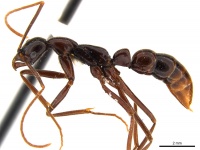Leptogenys linda
| Leptogenys linda | |
|---|---|

| |
| Scientific classification | |
| Kingdom: | Animalia |
| Phylum: | Arthropoda |
| Class: | Insecta |
| Order: | Hymenoptera |
| Family: | Formicidae |
| Subfamily: | Ponerinae |
| Tribe: | Ponerini |
| Genus: | Leptogenys |
| Species group: | luederwaldti |
| Species: | L. linda |
| Binomial name | |
| Leptogenys linda Lattke, 2011 | |
Nothing is known about the biology of Leptogenys linda.
Identification
Lattke (2011) - A member of the luederwaldti species group. Smooth and shining body except for transverse striae on propodeal dorsum, low propodeal denticle present, head elongate head, scape surpasses posterior cephalic margin by half its length; constriction between abdominal segments II and IV well marked.
Keys including this Species
Distribution
Latitudinal Distribution Pattern
Latitudinal Range: 4.5925° to 4.5925°.
| North Temperate |
North Subtropical |
Tropical | South Subtropical |
South Temperate |
- Source: AntMaps
Distribution based on Regional Taxon Lists
Distribution based on AntMaps
Distribution based on AntWeb specimens
Check data from AntWeb
Countries Occupied
| Number of countries occupied by this species based on AntWiki Regional Taxon Lists. In general, fewer countries occupied indicates a narrower range, while more countries indicates a more widespread species. |

|
Estimated Abundance
| Relative abundance based on number of AntMaps records per species (this species within the purple bar). Fewer records (to the left) indicates a less abundant/encountered species while more records (to the right) indicates more abundant/encountered species. |

|
Biology
|
Castes
Queens and males are unknown.
Nomenclature
The following information is derived from Barry Bolton's Online Catalogue of the Ants of the World.
- linda. Leptogenys linda Lattke, 2011: 185, fig. 39 (w.) COLOMBIA.
Type Material
- Holotype, worker, Cundinamarca, Medina, Miralindo, 1500 m, Colomblia, 4°35′33″N 73°23′17″W / 4.5925°N 73.38806°W, ii. – iv.1997, W.F. Escobar, Humboldt Institute.
Unless otherwise noted the text for the remainder of this section is reported from the publication that includes the original description.
This species is described from a single specimen yet it is so distinct from any others of its group on account of its large size, dominant smooth and shining sculpture, elongate head, propodeal denticles, and well marked gastral constriction. The possibility exists that the single specimen could be recently eclosed and the brownish color might eventually give way to black.
Description
Worker
Metrics, holotype: HL 1.89; HW 1.31; ML 1.18; EL 0.37; SL 2.59; PW 1.04; WL 3.27; PH 1.04; PL 1.04; DPW 0.54 mm. CI 0.70; MI 0.90; OI 0.28; SI 1.97; LPI 1.00; DPI 0.52.
Head elongate in full-face view, wider anterad than posterad, lateral cephalic margin straight to weakly convex, posterior cephalic margin straight; clypeal lobe blunt; lateral clypeal lobe shaped as broad convexity, stretching to same level as anterior margin of eye to mid diameter of antennal fossa. Eye diameter covers more than one-third lateral cephalic margin. Scape surpasses posterior cephalic border by half its length, third antennal segment 5 × its width, length of second antennal segment more than half length of third segment. Cephalic dorsal and ventral faces mostly smooth and shining with sparse piligerous punctulae. Mandibles mostly semiparallel, weakly widening apicad, preapical angle convex, basal margin broadly convex, external margin weakly concave medially, mandibular dorsum with fine longitudinal parallel striae, and scattered piligerous punctae. Stipes and labium smooth and shining.
Mesosoma with deep metanotal groove in lateral view, dividing promesonotal convexity from straight to weakly convex propodeal dorsal margin; propodeal dorsal margin more than 2 × length of declivitous margin; declivitous margin forms rounded obtuse angle with dorsal propodeal margin. Mesosoma mostly smooth and shining, some arched striae present at posterolateral pronotal area and posterior metapleuron; propodeal declivity transversely striate, low denticle present just dorsad of bulla; spiracle elongate, slightly elevated and posterolaterally facing. Mesonotum in dorsal view slightly longer than broad. Petiole subtriangular in lateral view, with brief convex anterior margin, broadly convex sloping anterodorsal margin that reaches posterior summit, posterior margin straight, not vertical but slightly sloping. Node in dorsal view elongate, gradually diverging posterad, anterior margin more than half width of posterior margin. Node smooth and shining. Gaster mostly smooth and shining with sparse piligerous punctulae; anterior margin of abdominal segment III forms single convexity in lateral view; constriction between segments III and IV well marked; pygidium with brief posteromedian crest. Coxae smooth and shining. Mandibles, antennae, legs, and gastral apex mostly ferruginous brown, rest of body brown. Scape with short subdecumbent pilosity, body with scattered sudecumbent fine hairs, large standing hair present mostly on clypeus, procoxa and gastral apex, some on head, and ventral body parts. Hairs golden.
Etymology
The species name alludes to sleek beauty of the ant. It is derived from the Spanish for beautiful, lindo.

